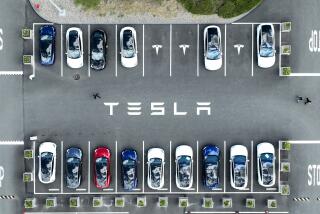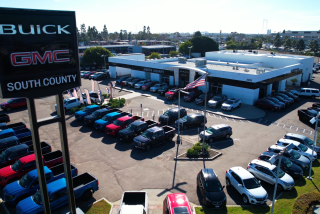GM High on New Chevrolet Models Despite Slow Start
DETROIT — They were supposed to reflect the change in thinking at General Motors.
The new Chevrolet Corsica and Beretta mid-size models were meant to symbolize a fresh start, a new willingness by GM to lay aside its cookie-cutter and try a non-traditional approach to car design.
As GM’s first significant attempt to break away from the rear-wedge design that has dominated its styling in recent years, the Corsica and Beretta were supposed to be so different from everything else GM sells that they would appeal to young, affluent import buyers who hadn’t visited a Chevy dealership in at least a decade.
But three months after their official introduction, Corsica and Beretta aren’t doing what they were supposed to do. Indeed, the cars are off to such a slow start that Chevrolet has been forced to use one of the oldest tricks in its sales book--cash rebates--to move them off the lots.
No one seems ready to write an obituary for Corsica and Beretta just yet--least of all Chevrolet officials. “Everybody keeps saying (they have) gotten off to a slow start, but I frankly don’t see it,” says Thomas Mason, Chevrolet’s passenger car marketing manager. “In fact, I don’t know one dealer who isn’t clamoring for more.”
Still, many industry analysts now argue that the cars have fallen far short of GM’s ambitious expectations. And they note that the mediocre sales couldn’t come at a worse time. Sales of GM’s older car lines have fallen sharply, and its share of the U.S. car market has eroded--dropping to just 35.5% of all cars sold in May, compared to 44% in the same month last year.
“The cars are not a great hit . . . and without the rebates they might flop,” says David Healy, automotive analyst with Drexel Burnham Lambert.
“The car is a positive step for GM, and I think the styling is a step in the right direction,” says Chris Cedergren, a sales analyst with J. D. Power & Associates, an automotive market research firm in Westlake Village, Calif. “But GM needs to go further than Corsica and Beretta to revitalize its dwindling market share.”
Analysts also warn that the lukewarm reception given Corsica and Beretta could also signal trouble for GM’s most ambitious product program of the late 1980s--the intermediate-sized car line code-named GM-10--when the first version, the Buick Regal, emerges next fall.
The GM-10’s launch has already been delayed, reportedly in order to give GM time to update the styling to compete with Ford’s highly successful Ford Taurus and Mercury Sable. But if the GM-10s are not perceived as being more distinctive than Corsica and Beretta, GM could have a big problem on its hands.
“GM hoped the Corsica-Beretta line would revitalize its market share, and it has not. . . . So now, you’ve got to ask what will happen with GM-10 this fall,” Cedergren says. “If GM-10 is not a hit, they’ll have a lot of empty assembly plants . . . and GM’s market share could really plummet.”
One of Slowest Launches
While sales of Corsica and Beretta picked up sharply in May after rebates went into effect, the car line, introduced in March, has been suffering through one of the slowest launches in the domestic auto industry in at least a decade, according to a recent study of new model introductions by the J. D. Power firm.
Sales were so slow at the end of April that GM could have halted production of the cars and still had enough on hand to meet demand for another 140 days.
The launch of Corsica and Beretta looks especially anemic when compared to the overwhelming customer response that greeted Taurus and Sable last year--products that were viewed as breaking the mold of traditional Detroit car design.
Ford’s backlog of unsold Taurus and Sable models two months after their December, 1985, introduction was only about a third that of Corsica and Beretta two months after their launch in March, according to industry statistics. And Ford offered no rebates or other incentives at that time.
With sales so far stuck at a seasonally adjusted annual rate of just 200,000 units, industry analysts say it is unlikely that Corsica and Beretta will reach GM’s ambitious goal of selling a half million of the cars annually anytime soon. (The seasonally adjusted annual rate is a reflection of the number of cars that would be sold if the monthly sales pace continued for a full year.)
Sticking With Goals
Nonetheless, Chevy officials are sticking to their sales targets.
“I think we will absolutely still (hit) 500,000 a year by next year,” responds Mason, adding that Chevy still hopes to sell 200,000 units by the end of the 1987 model year in September.
Still, what is perhaps most worrisome for GM is that the Corsica and Beretta aren’t living up to their advance billing as import-beaters. So far, many of their sales appear to be coming at the expense of older Chevrolet car lines, such as Cavalier, Camaro and Celebrity, whose sales have dropped since the Corsica and Beretta arrived.
“The Corsica and Beretta have just been pulling sales away from other Chevy models,” Cedergren says.
Chevy officials reluctantly agree. “There has been some cannibalization of sales from our other models,” Mason acknowledges. “The import-oriented buyer has been slow to develop. But hopefully, with Japanese car prices accelerating, those people will at least start to examine our cars.”
Mason insists, however, that he is satisfied with the Corsica-Beretta line’s early performance, especially since the cars have entered the market at a time when overall sales of new cars are sluggish.
“We were talking today about whether there was anything different we would do on the Corsica launch if we could do it over. And, very frankly, my answer is no,” he says. “There is no question that this is the most competitive market we’ve ever operated in. Could we sell more? Sure, but so could everyone else.”






